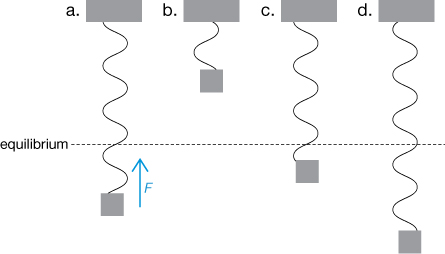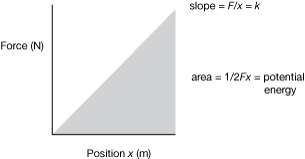Module 7—Oscillatory Motion
 Module 7: Lesson 1 Assignment
Module 7: Lesson 1 Assignment
Remember to submit the answer to TR 1 to your teacher as part of your Module 7: Lesson 1 Assignment.
 Try This
Try This
TR 1. To set up the simulation, click on the “Vectors” button (![]() ) and choose “acceleration at origin” on the popup menu. If the “Selected Vectors” popup menu does not display “acceleration at origin”, drag the green bar at the top of the popup upwards till all the choices are visible. Then click on the “Components” button (
) and choose “acceleration at origin” on the popup menu. If the “Selected Vectors” popup menu does not display “acceleration at origin”, drag the green bar at the top of the popup upwards till all the choices are visible. Then click on the “Components” button (![]() ) to show the acceleration vector. Now press “Play,” and observe the motion of the weighted spring and the corresponding acceleration vector. The acceleration vector is proportional in magnitude to the restoring force by Newton's second law (F = ma). Based on your observations, draw the restoring force on each of the images below. The first one has been completed as an example.
) to show the acceleration vector. Now press “Play,” and observe the motion of the weighted spring and the corresponding acceleration vector. The acceleration vector is proportional in magnitude to the restoring force by Newton's second law (F = ma). Based on your observations, draw the restoring force on each of the images below. The first one has been completed as an example.

For a weighted spring, the magnitude of the restoring force is determined by Hooke's law. Expressed as an equation, it is
![]()
| Quantity | Symbol | SI Unit |
| force | F | N |
| spring constant | k | N/m |
| displacement (amount of deformation) | x | m |

Graphing the force required to compress a spring vs. the displacement gives a slope that is equal to the spring constant.
Because the restoring force always acts in the opposite direction to the displacement, when using Hooke’s law to represent the restoring force, you must use −x in the formula ![]()
The slope of the line that you determined in “7-3 QuickLab” for SC 3 is the spring constant (k) for the spring you used.
Example Problem 1
A spring with a force constant of 55.0 N/m has a 0.250-kg mass suspended from it. How far does the spring stretch?
Solution

 Watch and Listen
Watch and Listen
Watch the video clip harmonic2.
 Read
Read
Read “Simple Harmonic Motion” and “Hooke’s Law” on pages 348 to 353 of your textbook.
 Self-Check
Self-Check
SC 4. Complete question 2 of “Practice Problems” on pages 352 of the textbook.
 Self-Check Answers
Self-Check Answers
SC 4. The spring constant is equal to the slope of the force-distance graph.

The spring constant is 15 N/m.
 Read
Read
Why is the spring constant important? Read “The Restoring Force” on pages 353 and 354 of the textbook.
 Self-Check
Self-Check
SC 5. Complete question 2 of “Practice Problems” on pages 354 of the textbook.
 Self-Check Answers
Self-Check Answers
SC 5.
Given
x = 0.550 m
k = 48.0 N/m
Required
the restoring force (F)
Analysis and Solution
The restoring force can be found from Hooke’s law.

Paraphrase
The restoring force of the spring is –26.4 N.
 Read
Read
In TR 1 you looked at the motion of a spring in the vertical position, where a restoring force kept bringing the object back to the equilibrium position. You saw that the farther the object was from the equilibrium position, the greater the restoring force and the acceleration of the object.
How is it different when a spring is in the horizontal plane than when it is in the vertical plane? Read “Simple Harmonic Motion of Horizontal Mass-spring Systems” on pages 354 and 355 in your textbook.
 Self-Check
Self-Check
SC 6.
- What forces are involved in the horizontal case?
- How is that different than the vertical case?
 Self-Check Answers
Self-Check Answers
SC 6.
- In the horizontal case, the restoring forces are only the tension and compression of the spring.
- In the vertical case, the force of gravity (the weight of the object) must be taken into account.
 Read
Read
Read “Simple Harmonic Motion of a Vertical Mass-Spring Systems” on pages 356 to 359 of your textbook.
 Self-Check
Self-Check
SC 7. Complete question 1 of “Practice Problems” on page 357 of the textbook. In this vertical case, the springs are compressed because the weight is above them instead of being stretched when a weight is suspended from the spring as in the previous example.
 Self-Check Answers
Self-Check Answers
SC 7.
Given
m = 275.0 kg
x = 5.00 cm
Required
the spring constant (k)
Analysis and Solution
Convert the displacement to metres. Divide the total mass by 4 to get the mass supported by each spring. Then use Hooke’s law to find the spring constant.

Paraphrase
The spring constant of the car springs is 1.35 × 104 N/m.